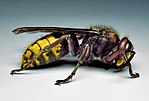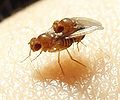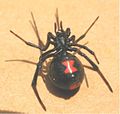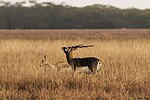Sexual selection in spiders shows how sexual selection explains the evolution of phenotypic traits in spiders. Male spiders have many complex courtship...
17 KB (2,244 words) - 20:21, 30 September 2024
Sexual selection is a mechanism of evolution in which members of one biological sex choose mates of the other sex to mate with (intersexual selection)...
54 KB (5,828 words) - 18:28, 29 September 2024
mainly through sexual selection. These differences may be subtle or exaggerated and may be subjected to sexual selection and natural selection. The opposite...
106 KB (12,402 words) - 02:23, 1 October 2024
Thomisidae (redirect from Crab spiders)
families of spiders. Many members of this family are also known as flower spiders or flower crab spiders. Members of this family of spiders do not spin...
20 KB (1,699 words) - 16:59, 15 September 2024
Sexual selection in insects is about how sexual selection functions in insects. The males of some species have evolved exaggerated adornments and mechanisms...
14 KB (1,752 words) - 11:24, 12 August 2024
also be seen in the chase-away sexual selection model, which places inter-sexual conflicts in the context of secondary sexual characteristic evolution, sensory...
67 KB (8,685 words) - 21:33, 27 August 2024
prominent sexual size dimorphism (SSD); extreme SSD likely drives this trait of sexual cannibalism in spiders. It also sometimes occurs in some anacondas...
45 KB (5,265 words) - 04:52, 17 June 2024
Orb-weaver spiders are members of the spider family Araneidae. They are the most common group of builders of spiral wheel-shaped webs often found in gardens...
43 KB (4,467 words) - 02:00, 15 August 2024
In 1889-1890, they published Observations on Sexual Selection in Spiders of the Family Attidae, and Additional Observations on Sexual Selection in Spiders...
12 KB (1,263 words) - 04:03, 23 April 2024
Fisherian runaway (redirect from Runaway sexual selection)
Fisherian runaway or runaway selection is a sexual selection mechanism proposed by the mathematical biologist Ronald Fisher in the early 20th century, to...
18 KB (2,123 words) - 23:52, 7 September 2024
Maratus (redirect from Peacock spiders)
Maratus is a spider genus of the family Salticidae (jumping spiders). These spiders are commonly referred to as peacock spiders due to the males' colorful...
29 KB (3,219 words) - 23:27, 21 August 2024
Secondary sex characteristic (redirect from Secondary sexual characteristics)
distinguish the sexes of a species. In evolution, secondary sex characteristics are the product of sexual selection for traits that show fitness, giving...
20 KB (2,047 words) - 20:01, 13 September 2024
seen in skeletal features such as the shape of the pelvis or the robustness of the skeleton. There are two mating systems in the sexual selection of primates...
25 KB (3,136 words) - 18:52, 11 May 2024
Nephila pilipes (category Spiders described in 1793)
pilipes spiders are able to achieve a large size because they can continue to molt and grow after maturity. This contrasts with most spiders, where growth...
26 KB (3,262 words) - 15:18, 6 June 2024
Myrmaplata plataleoides (category Spiders described in 1869)
male-male combat plays a crucial role in sexual selection. The spiders live in tres and bushes where the weaver ants live in colonies. By mimicking the ants...
8 KB (837 words) - 04:57, 10 September 2024
Courtship display (redirect from Sexual display)
of display behaviors in which an animal, usually a male, attempts to attract a mate; the mate exercises choice, so sexual selection acts on the display...
43 KB (5,228 words) - 03:01, 28 August 2024
Argiope aemula (category Spiders described in 1841)
decorated webs with spiders on the webs catch much more prey than decorated webs without spiders. Decorated webs without spiders, however, still catch...
16 KB (2,226 words) - 14:50, 14 August 2024
Pisaurina mira (redirect from American nursery web spider)
nursery web spider, due to the web it raises young in, is a species of spider in the family Pisauridae. They are often mistaken for wolf spiders (Lycosidae)...
18 KB (2,375 words) - 03:03, 2 September 2024
Jumping spiders are a group of spiders that constitute the family Salticidae. As of 2019, this family contained over 600 described genera and over 6,000...
45 KB (4,823 words) - 02:16, 21 September 2024
Larinioides sclopetarius (redirect from Bridge spider)
found in cities or other metropolitan areas. As a result, many urban areas have become saturated with these spiders. As many as 100 of these spiders can...
25 KB (3,070 words) - 18:24, 13 August 2024
Agelenopsis pennsylvanica (redirect from Pennsylvania grass spider)
incomplete in spiders. Spiders present a neurogenic heartbeat. Understanding the relationship between the heartbeat and the size of the spider may help...
32 KB (3,907 words) - 21:34, 21 September 2024
mating habits of spiders, in particular spiders belonging to the Latrodectus species. In 2007, she was named a Canadian Research Chair in Integrative Behavioural...
11 KB (831 words) - 13:17, 5 January 2024
Sex (redirect from Sex in plants)
such as in fungi, may be referred to as mating types. Sexual reproduction, in which two individuals produce an offspring that possesses a selection of the...
66 KB (7,646 words) - 11:51, 30 August 2024
Trichonephila clavipes (category Spiders described in 1767)
In many web-building spider species, including those of the Nephila genus, male spiders are only able to mate once due to behaviors such as sexual cannibalism...
22 KB (2,852 words) - 07:40, 8 July 2024
Cosmophasis umbratica (category Spiders described in 1903)
Pieridae, also display sexual signaling. The scientific name of this particular spider is Cosmophasis umbratica. These spiders are part of the genus Cosmophasis...
14 KB (2,010 words) - 22:46, 19 May 2023
Trichonephila plumipes (category Spiders described in 1804)
a species of spider found in Australia, Indonesia and some Pacific Islands, which exhibits extreme sexual dimorphism through its sexual cannibalism behavior...
20 KB (2,406 words) - 01:44, 13 June 2024
behaviour r/K selection theory Polygamy in house mouse Sexual behaviour of dogs Sexual behaviour of horses Non-reproductive sexual behavior in animals Kent...
128 KB (13,928 words) - 02:03, 3 September 2024
Maratus volans (redirect from Gliding spider)
species in the jumping spider family (Salticidae), belonging to the genus Maratus (peacock spiders). These spiders are native to certain areas in Australia...
18 KB (2,198 words) - 23:28, 21 August 2024
Nephilidae (redirect from Golden orb-weaving spider)
genera Herennia, Nephilengys and Nephilingis display extreme sexually driven selection. The pedipalps of these genera have become highly derived by evolving...
9 KB (895 words) - 12:18, 16 August 2024
Latrodectus hesperus (redirect from West black widow spiders)
Andrade, Maydianne C. B. (5 January 1996). "Sexual Selection for Male Sacrifice in the Australian Redback Spider". Science. 271 (5245): 70–2. Bibcode:1996Sci...
24 KB (2,961 words) - 08:15, 13 September 2024



























